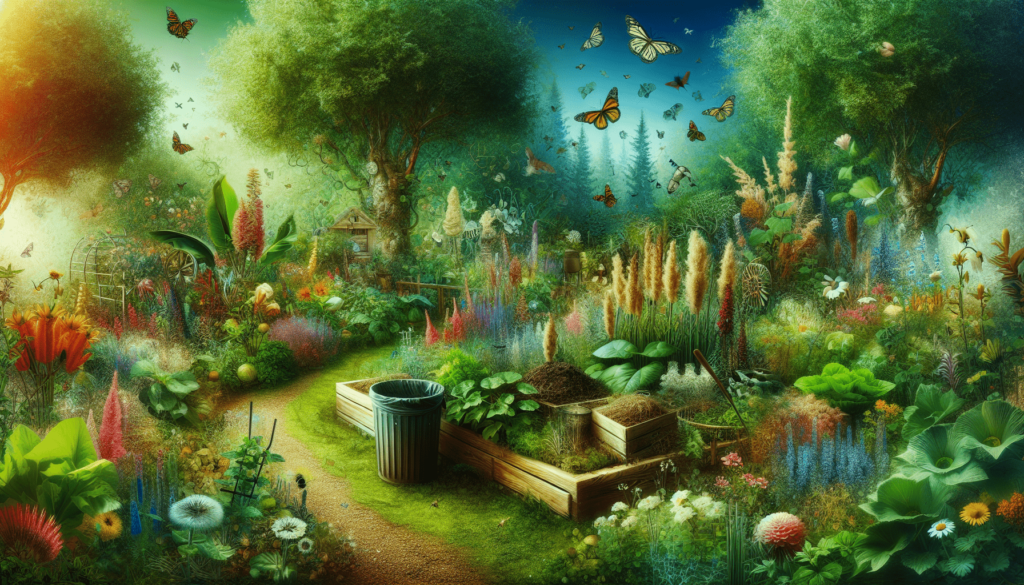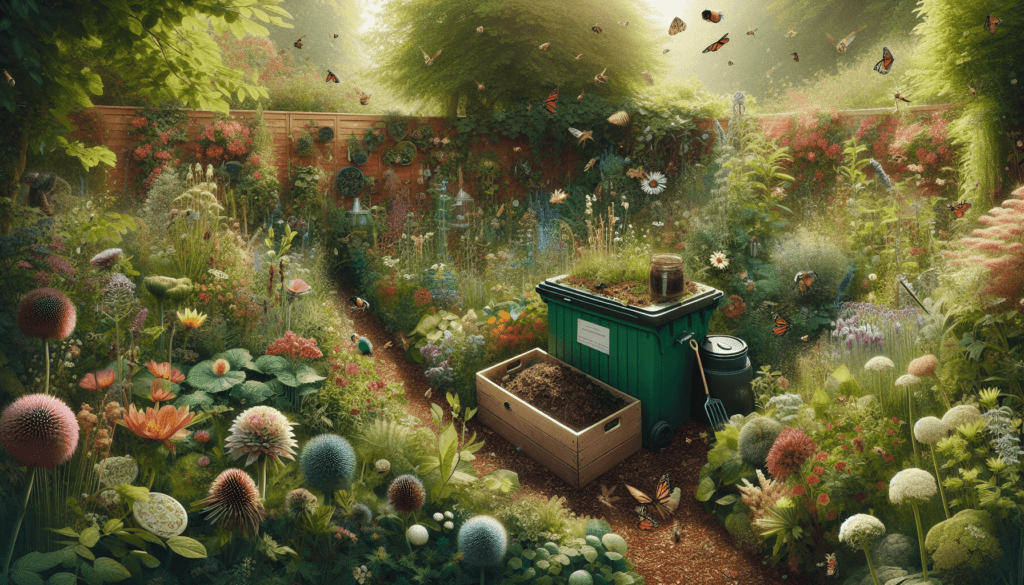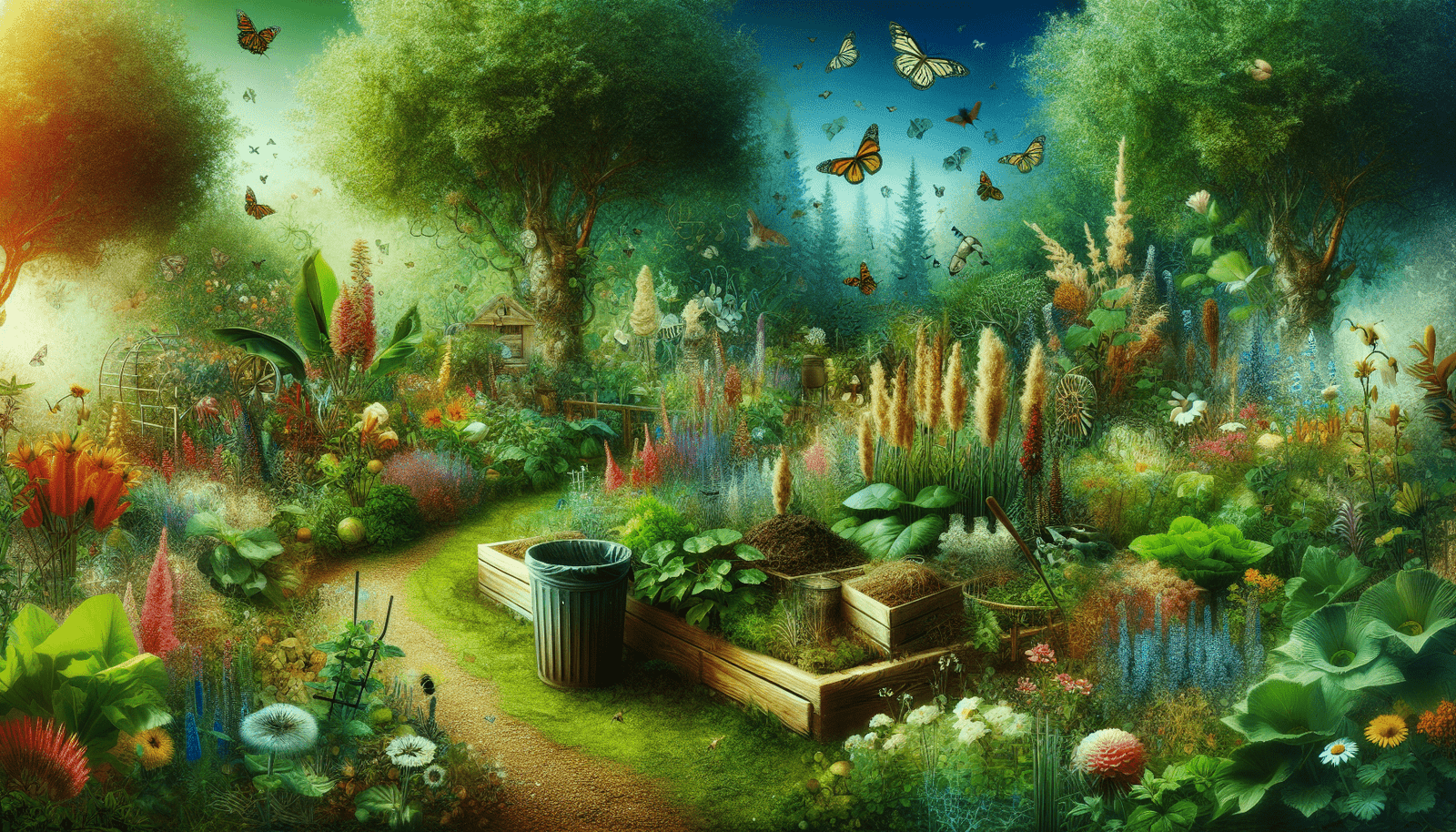Imagine creating a beautiful garden that not only provides stunning visuals but also takes care of itself. Sounds too good to be true? Well, it’s not! In this article, we will show you step by step how to create a self-sustaining garden ecosystem. From choosing the right plants to nurturing the soil, we will guide you on your journey to creating a thriving and low-maintenance garden that will bring joy and harmony to both you and nature. So, grab your gardening gloves and let’s get started on this exciting adventure!

Choosing the Right Plants
Consider native plants
When choosing plants for your garden, it’s important to consider native species. Native plants are well-suited to the local climate, soil conditions, and wildlife, making them more likely to thrive in your garden. Additionally, native plants are an essential part of the local ecosystem, providing food and habitat for birds, pollinators, and other wildlife.
Select a variety of plants for diversity
Creating a diverse garden is key to establishing a self-sustaining ecosystem. By selecting a variety of plants, you provide different habitats and food sources for a range of wildlife. Consider incorporating a mix of flowers, shrubs, trees, and grasses to create a balanced and visually appealing garden.
Choose plants with different blooming times
To support a diverse range of pollinators and beneficial insects, choose plants that bloom at different times throughout the year. By ensuring a continuous source of nectar and pollen, you’ll encourage a variety of pollinators to visit your garden. Additionally, having plants with staggered blooming times adds interest and color to your garden throughout the seasons.
Building Healthy Soil
Test the soil
Before you start planting, it’s important to test your soil. A soil test will determine its pH level and nutrient content, allowing you to understand what your plants need to thrive. You can purchase a soil testing kit or contact your local agricultural extension office for assistance.
Amend the soil with organic matter
To improve the fertility and structure of your soil, amend it with organic matter. This can include compost, well-rotted manure, leaf mulch, or other organic materials. Adding organic matter helps to increase nutrient availability, improve water retention, and enhance soil microbial activity.
Use compost and mulch
Compost and mulch are essential for maintaining healthy soil. Compost adds nutrients, microorganisms, and organic matter to the soil, while mulch helps retain moisture, suppress weeds, and regulate soil temperature. Both compost and mulch contribute to the overall health and fertility of your garden.
Creating a Watering System
Install a rain barrel
One of the most effective ways to conserve water and create a self-sustaining watering system is by installing a rain barrel. Rainwater is free and full of nutrients, making it an ideal source of water for your garden. Use the collected rainwater to irrigate your plants during dry periods, reducing your reliance on municipal water sources.
Set up drip irrigation
Drip irrigation is a water-efficient method of watering plants. It delivers water directly to the plants’ root zones, minimizing water waste through evaporation and runoff. Drip irrigation systems can be set on timers to ensure consistent watering, especially during times of drought.
Water deeply and infrequently
When watering your garden, it’s important to water deeply and infrequently rather than shallowly and frequently. This encourages plants to develop deep roots, making them more resilient and better able to access water during dry periods. Watering deeply also helps to prevent the spread of diseases and promotes overall plant health.
Attracting Beneficial Wildlife
Provide food sources for wildlife
To attract beneficial wildlife to your garden, provide a variety of food sources. Native plants that produce berries, seeds, or nectar are particularly attractive to birds, butterflies, and other pollinators. Consider planting fruit trees, flowering shrubs, and perennials that offer food throughout the year.
Create shelter and nesting areas
Wildlife needs shelter and nesting areas to thrive. Include a mix of vegetation heights, such as tall trees, shrubs, and ground cover, to provide different levels of shelter. Leave areas of your garden undisturbed, allowing leaves, fallen branches, and other natural debris to serve as nesting sites for birds, insects, and other wildlife.
Avoid using chemical pesticides and herbicides
Chemical pesticides and herbicides can have detrimental effects on beneficial wildlife, disrupting the delicate balance of your garden ecosystem. Instead, try using natural alternatives, such as companion planting, biological controls, and manual removal of pests. By avoiding harmful chemicals, you’ll create a healthier environment for both your garden and the wildlife it supports.

Implementing Companion Planting
Pair plants with complementary needs
Companion planting involves strategically placing plants that have complementary needs next to each other. For example, planting nitrogen-fixing legumes next to nitrogen-loving vegetables can help improve soil fertility. Similarly, growing tall sunflowers next to delicate lettuce plants can provide shade and protection from the wind.
Repel pests by interplanting
Certain plants have natural pest-repellent properties. Interplanting these pest-repellent plants with susceptible crops can help deter pests naturally. For example, planting marigolds alongside tomatoes can help repel nematodes, while aromatic herbs like basil and rosemary can deter aphids and other pests.
Promote pollination with companion flowers
To attract pollinators and improve the pollination of your crops, incorporate companion flowers into your garden. Flowers such as lavender, borage, and echinacea are attractive to bees, butterflies, and other pollinators. Having companion flowers interspersed throughout your garden can increase pollination rates and maximize fruit and seed production.
Utilizing Natural Pest Control
Encourage predator insects
Encouraging natural predators like ladybugs, lacewings, and birds can help keep pest populations in check. Provide habitat and food sources for these predators by planting native flowers, shrubs, and trees. Avoid using broad-spectrum insecticides that can harm beneficial insects and disrupt the natural balance of your garden.
Practice crop rotation
Crop rotation is an effective pest control technique that helps break the pest life cycle and reduce pest pressure. By rotating your crops each year, you prevent pests from building up in the soil and decrease the chances of plant diseases spreading. Additionally, rotating crops can help improve soil fertility and overall garden health.
Use organic pest control methods
If natural predators and crop rotation aren’t enough to control pests, consider using organic pest control methods. These can include insecticidal soap, neem oil, diatomaceous earth, and beneficial nematodes. Organic pest control methods are generally safer for the environment, as they target specific pests without harming beneficial insects.
Maintaining Balance in the Garden
Monitor for imbalances
Regularly monitor your garden for any signs of imbalances or issues. Look for pest infestations, nutrient deficiencies, or diseases that may be affecting your plants’ health. Catching these imbalances early allows you to take appropriate action and prevent them from spreading or becoming worse.
Control invasive species
Invasive species can quickly take over your garden, outcompeting native plants and disrupting the ecosystem. Be vigilant about identifying and removing invasive plants promptly. Consult with local experts or extension offices for guidance on invasive species in your area.
Remove diseased plants promptly
If you notice any signs of disease in your garden, such as wilting, discoloration, or pest damage, remove the affected plants promptly. Diseased plants can harbor pathogens that can spread to other plants, leading to further damage. Proper disposal of diseased plants can help prevent the spread of diseases and maintain garden health.
Conserving Water and Energy
Collect and reuse rainwater
Maximize water conservation by collecting and reusing rainwater in your garden. Install rain barrels or other rainwater harvesting systems to capture runoff from your roof. By using rainwater instead of municipal water sources, you can decrease your water consumption and reduce strain on local water resources.
Choose energy-efficient garden tools
Selecting energy-efficient garden tools can not only help conserve energy but also make your gardening tasks easier. Look for tools with energy-saving features, such as rechargeable batteries, adjustable power settings, or manual options. Using energy-efficient tools reduces your carbon footprint and saves money on energy bills.
Minimize water evaporation
Prevent water evaporation by using mulch to cover the soil around your plants. A layer of organic mulch, such as wood chips or straw, helps retain moisture and regulate soil temperature. By minimizing water evaporation, you’ll maximize the efficiency of your watering system and reduce overall water usage.
Managing Weeds
Use mulch to suppress weeds
Mulch is not only beneficial for retaining moisture but also for suppressing weed growth. A thick layer of mulch deprives weeds of sunlight and prevents them from establishing and competing with your desired plants. Organic mulch materials, like wood chips or straw, are particularly effective for weed suppression.
Pull weeds before they go to seed
To prevent the spread of weeds, it’s important to pull them out before they have a chance to go to seed. Weeds produce an abundance of seeds that can lay dormant in the soil for years, leading to ongoing weed problems. Regularly inspect your garden for weeds and remove them by the root to minimize their impact.
Plant cover crops to prevent weed growth
Cover crops, also known as green manure, are fast-growing plants that can be grown in between planting seasons. Cover crops help keep the soil covered and prevent weed seeds from germinating. Additionally, they add organic matter to the soil when they are turned under, improving soil fertility for future plantings.
Continual Learning and Adaptation
Stay curious and open-minded
Maintaining a self-sustaining garden ecosystem is a continuous learning process. Stay curious and open-minded about new techniques, plants, and ideas. Attend workshops, read books, and join gardening communities to expand your knowledge and stay up-to-date with the latest developments in sustainable gardening.
Experiment with different techniques
Don’t be afraid to experiment and try new gardening techniques. Every garden is unique, and what works for one may not work for another. By experimenting with different approaches, you’ll discover what methods are most effective for your specific garden ecosystem. Embrace the opportunity to learn from both successes and failures.
Adapt to the specific needs of your garden
Finally, remember that every garden has its own specific needs and requirements. Pay attention to the unique characteristics of your garden, such as sun exposure, soil type, and drainage. Adapt your gardening practices accordingly, tailoring them to meet the needs of your plants, wildlife, and ecosystem as a whole. With time and dedication, you’ll create a healthy and self-sustaining garden ecosystem that thrives year after year.

